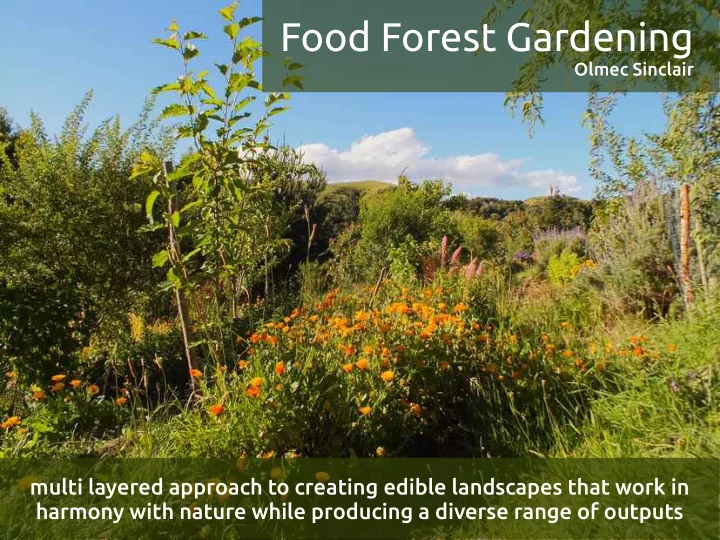

Food Forest Gardening Olmec Sinclair multi layered approach to creating edible landscapes that work in harmony with nature while producing a diverse range of outputs
What's wrong with 'normal' farming? Biologically simple Technologically complex
Achieves: ✔ Deep compaction ✔ Destroys soil life
monotonous & ugly!
Feed the people? Feed the cows!
Aztec 'city' on lake Texcoco Now Mexico City Floatings gardens (Chinampas)
Horticultural societies Early agriculture Yanomami – Amazon rainforest Originates in fertile crescent and Aztec – Mexio city spreads (both ideas and genes) Hunt, gather, forest garden
What is a food forest?
Blockhill food forest and gardens ● 1.5 hectares ● Planting started 2011
Forest Gardening ● A natural garden consisting primarily of annuals located on the sunny edges and clearings in the food forest ● Can include water harvesting features such as swales and wood mounds. ● Biological pest control and nutrient sources
Creating a food forest
Empty fj fjeld ● More design freedom ● Fewer existing niches November 2011
3 years later
Maximise edge
Spiral contains maximum edge
Exploit positive plant interactions
Layers / components
1.Birds - Pest control, nutrient delivery 2.Canopy / climax - large fruit and nut trees, shelter 3.Climbers 4.Low tree – some nuts, dwarf fruit, scafgold 5.Shrub – Berries, currants 6.Herbaceous – Herbs, salad, nutrient accumulators, nectar, insect habitat 7.Animals – Pest control, nutrient delivery and yield 8.Surface – Ground cover 9.Aquatic / wetland 10.Fungi 11.Underground – root vegetables, tubers, rhizomes, helpers (worms etc.)
Set realistic expectations
Tomato?
Perennials! Plant it once Fruit & nut trees Berries, brambles, currants etc. Asparagus Rhubarb Artichoke Potato Runner beans Some brassica Some garlic/onions/leeks Self seeding annuals Silver beet Kale Many salad greens Carrot Radish Tomato Beans and peas
Getting a return Timing of various yields 1. Annual vegetables 2. Chickens for eggs and meat 3. Herbs 4. Berries and currants 5. Plant material (seeds, new plants, grafting wood) 6. Stone fruit (peach, apricot, plum) 7. Pip fruit (apple, pear, fjg) 8. Firewood 9. Nuts 10. Timber
Food, Fibre, Medicine
Hugelkultur – Log fjlled swales
Exploit the third dimension Hardy kiwi climbs Italian Alder
Grape in Tagasaste over citrus
Locate or create the niche Avocado under evergreen canopy Inside plastic house
Tagasaste canopy over young citrus
Kiwifruit on water tank
Changes over time Effort Output Diversity
Passive irrigation swales
Passive irrigation swales
Fertility (compost tea)
Chop & drop Produce your own mulch with frequent trimming of fast growing leafy green trees and shrubs
Common nitrogen fjxing plants Small plants & shrubs Larger trees Clover, vetch, lucerne Albizia (silk tree) ● ● Peas and beans Kowhai ● ● Lupine Alnus species (alders) ● ● Broom Black locust ● ● Licorice Acacia species (wattles) ● ● Small trees Climbers Siberian pea tree Sweet pea ● ● Tagasaste (tree lucerne) Wisteria ● ● Elaeagnus ● Sea buckthorn ● Judas tree ●
Animals Ducks: food, fertility & pest control
Pigs add fertility
Chickens eat bugs, break pest cycles
Working with 'weeds' Managing natural succession ● Disruption – Fire – Erosion / landslip – Overgrazing – Cultivation ● Pioneers and 'weeds' – Fast growing – Deep rooted – Soil builders, nutrient accumulators
Soil health and improvement Grow mulch and biomass on site, keep soil covered Use deep rooted plants to break open clay, improve water infjltration and inject organic mater ● Fennel ● Parsnip ● Radish ● Dandelion ● Dock ● Mullion Compost everything, burn nothing
King of the mulch!
Not just food for people! ● Stack functions. Planting can provide: – Wind break – Fodder – Habitat – Fencing – Firewood – Soil improvement ● Support, scafgold, companion, benefjcial plants ● Fibre ● Medicine ● Fodder, sacrifjce / ofgering for ecosystem inhabitants Greenfjnch eat brassica seed
Umbelliferous fmowering plants for attracting benefjcial insects ● Parsnip ● Carrot ● Celery ● Parsley ● Yarrow ● Fennel & dill
Planting patterns
Contour
Bubble and cluster
Guilds
Difgerent root profjle of guild members
Sheet and contour
Transforming an existing backyard orchard
July 2014
November 2014
Plant propagation ● Food forestry requires a lot of plants ● Learn to propagate your own – Seed saving – Stem and root cuttings – Grafting and budding Japanese raisin tree
Tools Scythe, sickle Loppers and secateurs Pruning saw
Find out more at www.blockhill.co.nz
Recommend
More recommend